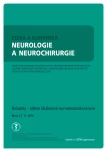Evaluation of Selected Pressure Ulcer Management International Guidelines (AGREE II Tool)
Authors:
S. Saibertová 1; A. Pokorná 1; S. Vasmanská 1; P. Búřilová 1; N. Müllerová 2; L. Fiedlerová 2; D. Svobodová 3; P. Camprová 3; G. Šmelková 3; L. Kubátová 4
Authors‘ workplace:
Katedra ošetřovatelství, LF MU, Brno
1; LF UK a FN Plzeň
2; 1. LF UK a VFN v Praze
3; ÚVN – VFN Praha
4
Published in:
Cesk Slov Neurol N 2016; 79/112(Supplementum1): 40-44
Category:
Original Paper
doi:
https://doi.org/10.14735/amcsnn2016S40
Overview
Aim:
The aim of this study was to analyse methodological quality of selected clinical guidelines for the management of pressure ulcers with the use of AGREE II tool.
Material and methods:
Descriptive study with qualitative research methodology. The evaluated clinical guidelines were identified and selected through a literature search and according to suggestions from international scientific societies focused on wound management. In total, four pairs of assessors evaluated methodological quality of four international clinical guidelines using the AGREE II tool (the Appraisal of Guidelines for REsearch & Evaluation). Six domains of quality were evaluated: Scope and Purpose, Stakeholder Involvement, Rigour of Development, Clarity of Presentation, Applicability, Editorial Independence.
Results:
The selected clinical guidelines had relatively high methodological quality and all of them were suggested for use in clinical practice by the assessors after some minor corrections with respect to the Czech clinical practice. All of the evaluated guidelines had the highest score in the Scope and Purpose domain (more than 80%). There were rather substential differences in other domains. The lowest score was in the following domains : Applicability Rigour of Development and Editorial Independence.
Conclusion:
Methodological quality of all selected and evaluated clinical guidelines for the management of pressure ulcer was quite high except the Editorial Independence and Rigour of Development domains. Evaluation of clinical guidelines with the use of AGRE II was conducted as part of a process of adaptation of clinical guidelines for the Czech healthcare settings. Overall methodological quality was the highest for the Prevention and Treatment of Pressure Ulcers : Quick Reference Guide (85.71%).
Key words:
clinical guidelines – management of pressure ulcer – methodological quality –AGREE II tool
The authors declare they have no potential conflicts of interest concerning drugs, products, or services used in the study.
The Editorial Board declares that the manuscript met the ICMJE “uniform requirements” for biomedical papers.
Sources
1. Field MJ, Lohr KN. Guidelines for Clinical Practice. From Development to Use. Washington (DC): National Academies Press (US) 1992. [online]. Available from URL: http:/ / www.ncbi.nlm.nih.gov/ books/ NBK234503.
2. Woolf SH, Grol R, Hutchinson A, et al. Potential benefits, limitations, and harms of clinical guidelines. BMJ 1999;318:527– 30.
3. Woolf SH, Grol R, Hutchinson A, et al. An international overview. In Eccles MP, Grimshaw JM, eds. Clinical practice guidelines. Oxford: Radcliffe Medical Press Ltd 2000.
4. Siebenhofer A, Semlitsch T, Siering U, et al. Validation and reliability of a guideline appraisal mini-checklist for daily practice use. BMC Medical Research Methodology 2016;16:39. doi: 10.1186/ s12874-016-0139-x.
5. AGREE Collaboration. Development and validation of an international appraisal instrument for assessing the quality of clinical practice guidelines: the AGREE project. Qual Saf Health Care 2003;12(1):18– 23.
6. Pokorná A. Problematika prevence dekubitů s ohledem na soudobé poznatky a závěry empirických studií. Hojení Ran 2013;4:7– 11.
7. Brouwers MC, Kho, ME, Browman, GP, et al. The Global Rating Scale complements the AGREE II in advancing the quality of practice guidelines. J Clin Epidemiol 2012;65(5):526– 34. doi: 10.1016/ j.jclinepi.2011.10.008.
8. Fehring, RJ. Methods to validate nursing diagnoses. Heart Lung 1987,16(6):625– 9.
9. Levin, R. Who Are the Experts? A Commentary on Nursing Diagnosis Validation Studies. Nurs Diagn 2001,12(1):29– 32.
10. Líčeník R, Kurfürst P, Ivanová K. AGREE II: Nástroj pro hodnocení doporučených postupů pro výzkum a evaluaci. Olomouc: Univerzita Palackého v Olomouci 2013.
11. Jo HS, Kim DI, Oh MK. National Priority Setting of Clinical Practice Guidelines Development for Chronic Dis-ease Management. J Korean Med Sci 2015; 30(12):1733– 42.doi: 10.3346/ jkms.2015.30.12.1733.
12. National Pressure Ulcer Advisory Panel, EuropeanPressure Ulcer Advisory Panel and Pan Pacific. Pressure Injury Alliance. Prevention and Treatment of Pressure Ulcers: Quick Reference Guide. Haesler E, ed.Cambridge Media: Osborne Park, Australia 2014. [online]. Available from URL:http:/ / international-pressure-ulcer-guidelines.myshopify.com.
13. Sabharwal S, Patel NK, Gauher S, et al. High methodologic quality but poor applicability: assessment of the AAOS guidelines using the AGREE II instrument. Clin Orthop Relat Res 2014;472(6):1982– 8. doi: 10.1007/ s11999-014-3530-0.
14. Parisi P, Vanacore N, Belcastro V, et al. Clinical guidelines in pediatric headache: evaluation of quality using the AGREE II instrument. J Headache Pain 2014;1(15):57. doi: 10.1186/ 1129-2377-15-57.
15. Smith CA, Toupin-April K, Jutai JW, et al. A Systematic Critical Appraisal of Clinical Practice Guidelines in Juvenile Idiopathic Arthritis Using the Appraisal of Guidelines for Research and Evaluation II (AGREE II) Instrument. PLoS One 2015;10(9):e0137180. doi: 10.1371/ journal.pone.0137180.
16. Pressure ulcers: prevention and management, NICE guidelines 2014. [online]. Available from URL: http:/ / www.rcpch.ac.uk/ system/ files/ protected/ page/ NICE%20CG%20Pressure%20ulcers%20(prevention%20and%20management)%20PUBLISHED_2.pdf.
17. A SELF-HELP GUIDE, Pressure Ulcers, Prevention and Treatment 2010. [online]. Available from URL: http:/ / dmsystems.com/ pdf/ PUSelfHelpGuide.pdf.
18. Prevention and Treatment of Pressure Ulcers: Quick Reference Guide 2014. [online]. Available from URL: http:/ / www.npuap.org/ wp-content/ uploads/ 2014/ 08/ Updated-10-16-14-Quick-Reference-Guide-DIGITAL-NPUAP-EPUAP-PPPIA-16Oct2014.pdf.
19. National best practice and evidence based guidelines for wound management 2009. [online]. Available from URL: http:/ / www.lenus.ie/ hse/ bitstream/ 10147/ 92646/ 1/ HSE+Wound+Management.pdf.
Labels
Paediatric neurology Neurosurgery NeurologyArticle was published in
Czech and Slovak Neurology and Neurosurgery

2016 Issue Supplementum1
Most read in this issue
- Sorrorigens Wounds, Their Identification and Treatment Process
- Incontinence-associated Dermatitis – Current Knowledge on Etiology, Diagnosis and Prevention
- The Importance and Limits of the Pressure Ulcer Surgical Debridement
- The Relevance of Pressure Mapping System in Wheelchair Mobility
